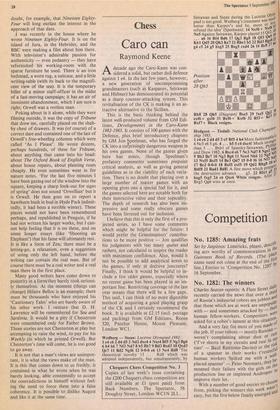Chess
Caro can
Raymond Keene
Adecade ago the Caro-Kann was con- sidered a solid, but rather dull defence against I e4. In the last few years, however, a new generation of uncompromising
grandmasters (such as Kasparov, Seirawan and Hubner) has demonstrated its potential as a sharp counter-attacking system. This revitalisation of the CK is making it an at- tractive alternative to the Sicilian.
This is the basic thinking behind the latest well-produced volume from GM Edi- tions, Developments in the Caro-Kann 1982-1983. It consists of 100 games with the Defence, plus brief introductory chapters by GM Jon Speelman, who has forged the CK into a surprisingly dangerous weapon in his own games. None of the games given here has notes, though Speelman's prefatory comments sometimes pinpoint critical analysis, as well as giving general guidelines as to the viability of each varia- tion. There is no doubt that playing over a large number of master games with an opening gives one a special feel for it, and the games selected here are notable both for their instructive value and their topicality. The depth of research has also been im- pressive and some really obscure games have been ferreted out for inclusion.
I believe that this is only the first of a pro- jected series, so I have some comments which might be helpful for the future: I would prefer the Grandmasters' contribu- tions to be more positive — Jon qualifies his judgments with too many quites and rathers, not calculated to inspire the reader with maximum confidence. Also, would it not be possible to add analytical notes to the games, if only at decisive junctures? Finally, I think it would be helpful to in- clude a few older games, especially where no recent game has been played in an im- portant line. Restricting coverage to the last year means that there will be a few gaps. This said, I can think of no more digestible method of acquiring a good playing grasp of the CK and I certainly recommend the book. It is available at £2.15 (incl. postage and packing) from GM Editions, Room 320, Panther House, Mount Pleasant, London WCI.
Wedberg — Stean: Lucerne Olympiad 1982.
1 e4 c6 2 d4 d5 3 Nd2 dxe4 4 Nxe4 Bf5 5 Ng3 Bg6 6 h4 h6 7 Nf3 Nd7 8 h5 Bh7 9 Bd3 Bxd3 10 Qxd3 Qc7 11 Bd2 Ngf6 12 0-0-0 e6 13 Ne4 Rd8 'The theoretical novelty 13 , Rd8 which was adopted independently, but simultaneously, by Seirawan and Stean during the Lucerne
pad is not good. Wedberg's treatment was much better than Karpov's and he, more or lel refuted the idea' (Speelman). 14 Nxit + 0,6 !3 Ne5 Against Seirawan, Karpov played 15 Qeh,. i9 a6 16 Bf4 Bd6 17 Qg3 Rg8 18 QV Oa'. ij Kbl Qd5 20 Qh3 Ke7 21 Rhel b5 22 Rd3 Rge°:6 g4 c5 24 g5 hxg5 25 BxgS cxd4 26 f4 Rc8 2'
"
Position after 28 Qh5
30
Rh8 28 Qh5 (Diagram) BxeS 29 fxe5 Q8- exit + gxf6 31 Bxf6 + Kxf6 32 Rf3 + Ke7•"- Rxf7 + Black resigns.
Hodgson — Tisdall: National Club ChafflPi°11.
ship 1983. is 1 e4 c6 2 d4 d5 3 e5 Bf5 4 h4 More fashionab,e, 4 Nc3 e6 5 g4. 4 ... h5 5 c4 dxc4! Much stronPs than 5 ... Bxbl of Spassky-Seirawan, and Drew 1982. 6 Bxc4 e6 7 Nc3 Nd7 8 Nget"bf5 9 Bb3 Bel 10 Ng3 Bg6 11 Nce4 Nh6 12 NV 13 Nxf5 Bxf5 14 Be3 Qd7 15 0-0 f6 16 Nf3 17 Bc2 0-0-0 18 BxfS exf5 19 Qd2 RhgS 2 "s Rdf8 21 Rad 1 Bd8! A fine move which prepar75 the destructive advance g5. 22 Rfe1 g5 hxg5 FxgS 24 e6 Qxe6 White resigns. After BxgS Qg6 wins at once,


































 Previous page
Previous page